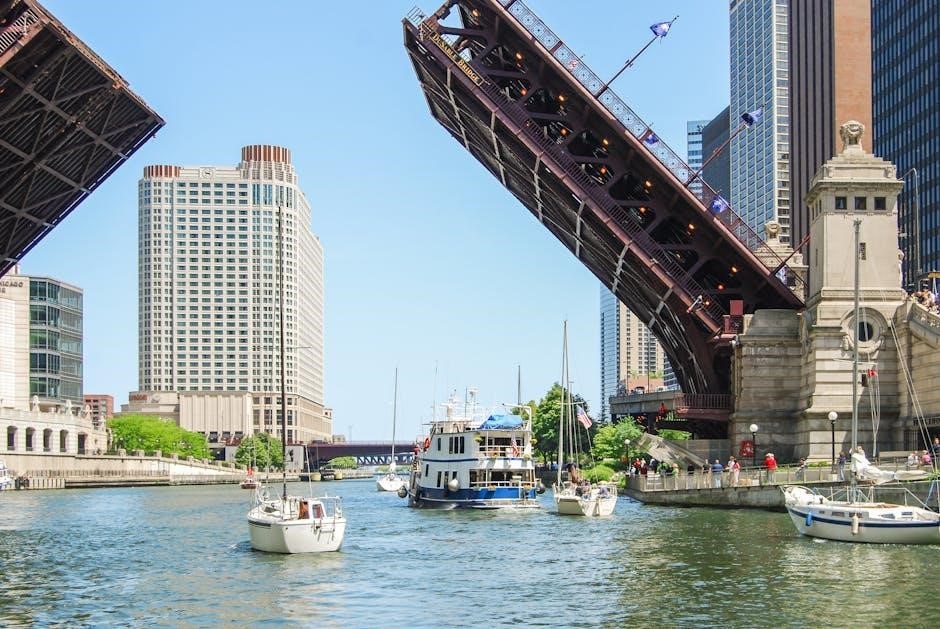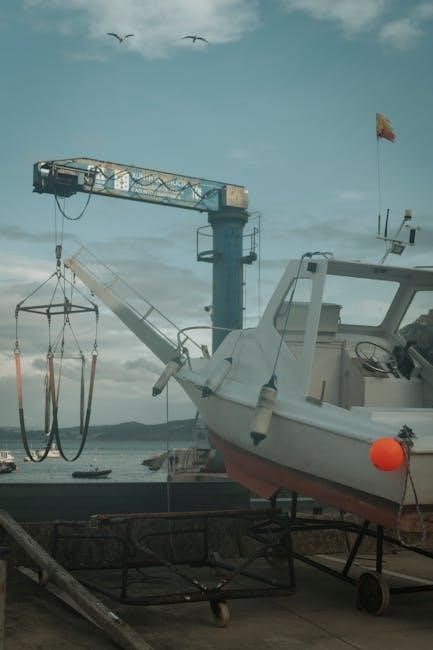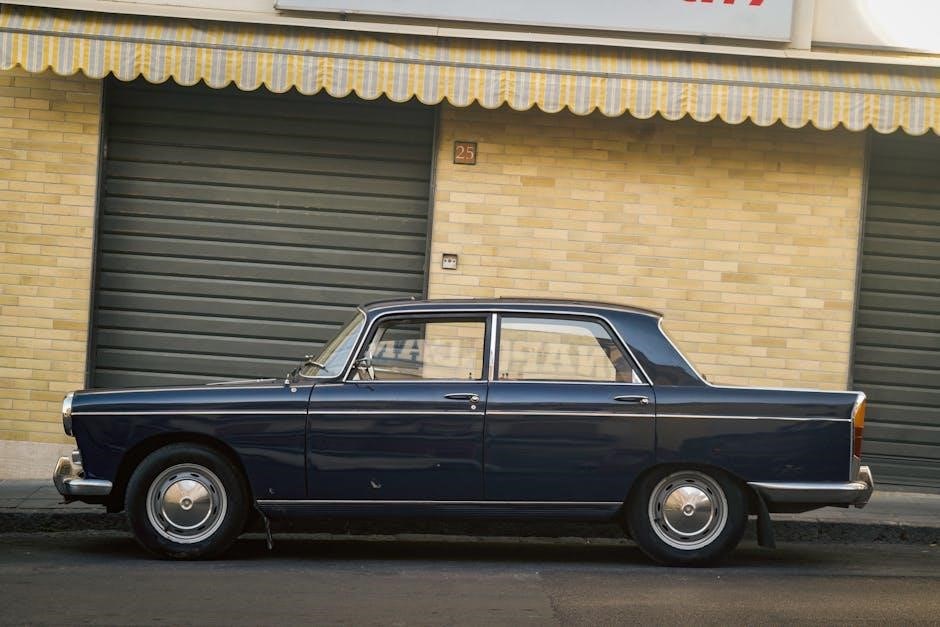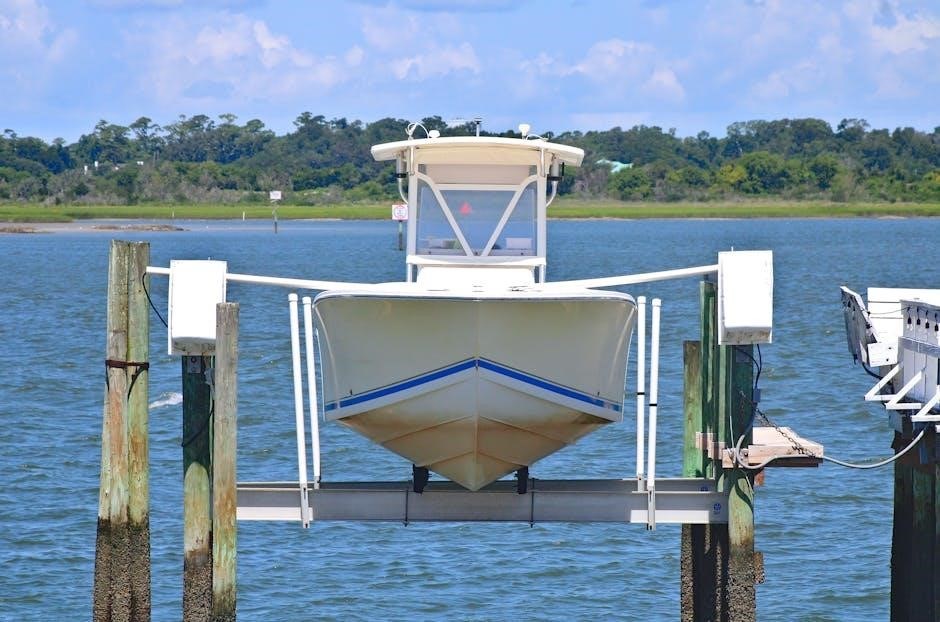Boat lift guide bumpers are essential for safe and efficient boat lifting operations, offering protection and alignment support during the process. They enhance safety and hull protection while ensuring smooth boat handling, making them a crucial component for any boat lift system. Properly installed guide bumpers minimize damage risks and simplify docking maneuvers, ensuring a secure and stress-free boating experience.
What Are Boat Lift Guide Bumpers?
Boat lift guide bumpers are protective devices installed on boat lifts to guide the boat during lifting and lowering, preventing damage from impacts or misalignment. Typically made of durable materials like polyurethane or PVC, they absorb shocks and provide a cushioned surface for the boat’s hull. These bumpers are essential for maintaining proper alignment and ensuring smooth operation, whether the lift is manual or automatic. They play a critical role in safeguarding both the boat and the lift system, enhancing overall safety and efficiency during docking and storage.
Why Are Guide Bumpers Essential for Boat Lifts?
Guide bumpers are vital for boat lifts as they provide protection during lifting and lowering, preventing damage to the boat’s hull and lift structure. They ensure proper alignment, reducing the risk of mispositioning and potential accidents. By absorbing shocks and impacts, they minimize wear and tear, extending the lifespan of both the boat and the lift. Their presence enhances safety, operational efficiency, and overall system durability, making them indispensable for smooth and secure boat handling in various water conditions.
Types of Boat Lift Guide Bumpers
Boat lift guide bumpers come in various types, including fixed and adjustable models, as well as removable and permanent options, each designed to suit specific docking needs and preferences.
Fixed vs. Adjustable Guide Bumpers
Fixed guide bumpers are permanently installed on a boat lift, offering consistent support but limited flexibility. Adjustable bumpers, however, allow customization to fit various boat sizes and docking conditions, enhancing versatility. While fixed bumpers are durable and low-maintenance, adjustable ones provide adaptability for different vessels and water levels, making them ideal for boat owners with multiple watercraft or changing docking needs. Both options ensure safe boat handling, but the choice depends on specific user requirements and preferences.

Removable vs. Permanent Guide Bumpers
Removable guide bumpers offer flexibility, allowing easy detachment for maintenance or seasonal adjustments, while permanent bumpers are fixed for consistent support. Removable bumpers are ideal for versatility, accommodating different boat sizes or water levels. Permanent bumpers provide long-term reliability but lack adaptability. The choice depends on specific needs, with removable options suiting multi-boat users and permanent ones offering stability for consistent operations. Both ensure safety, but removable bumpers add convenience for dynamic conditions.

Materials Used for Boat Lift Guide Bumpers
Boat lift guide bumpers are typically made from durable materials like polyurethane, PVC, or rubber, offering resistance to water, UV exposure, and heavy use. These materials ensure longevity.
Polyurethane Guide Bumpers
Polyurethane guide bumpers are a popular choice for boat lifts due to their exceptional durability and resistance to water, UV light, and abrasion. They provide a smooth, non-marring surface that protects boat hulls from scratches and dings. Their flexibility allows them to absorb impacts effectively, reducing wear on both the bumper and the boat. Polyurethane bumpers are also low maintenance and can withstand harsh marine environments, making them a long-lasting solution for boat lift systems. Their versatility ensures they can be used across various boat sizes and types.
PVC and Rubber Guide Bumpers

PVC and rubber guide bumpers are cost-effective solutions for boat lifts, offering excellent shock absorption and quiet operation. PVC bumpers are lightweight, resistant to marine environments, and easy to install. Rubber bumpers, known for their flexibility, provide superior cushioning and durability. Both materials are low maintenance and suitable for various water conditions. They are ideal for smaller boats or budgets, ensuring reliable performance while protecting both the boat and lift from damage during raising and lowering operations.
Installation and Maintenance
Proper installation techniques ensure safety and effectiveness, while regular maintenance, including inspections and cleaning, maintains performance and longevity of the guide bumpers.

How to Install Guide Bumpers on a Boat Lift
Installing guide bumpers requires careful preparation and precision. Start by examining the boat lift structure and identifying the optimal positions for the bumpers. Measure the width of the lift and ensure the bumpers align with the boat’s hull. Attach the bumpers using durable hardware, such as stainless steel screws or bolts, to withstand marine conditions. Tighten all fasteners securely, but avoid over-tightening to prevent damage. Finally, test the system by lowering and raising the boat to ensure smooth operation and proper alignment.
Maintenance Tips for Long-Lasting Performance
Regular maintenance ensures guide bumpers perform optimally. Inspect them frequently for signs of wear, such as cracks or fading, and replace them promptly if damaged. Clean the bumpers and surrounding areas to prevent debris buildup, which can cause friction and deterioration. Lubricate moving parts if applicable, and tighten any loose hardware. Additionally, store bumpers in a dry, protected area during off-seasons to prevent weather-related damage. Proper care extends their lifespan and maintains their protective function for your boat lift system.
Selecting the Right Guide Bumpers
Selecting the right guide bumpers is crucial for optimal boat lift performance. Consider factors like boat size, lift type, and material durability to ensure a proper fit and meet specific needs such as load capacity and environmental conditions.
Factors to Consider When Choosing Guide Bumpers
When selecting guide bumpers, consider your boat’s size, lift type, and material durability. Environmental conditions, such as water salinity or extreme temperatures, also play a role. Ensure the bumpers are compatible with your lift’s structure and can handle the boat’s weight. Proper fit and alignment are crucial to prevent damage and ensure smooth operation. Additionally, evaluate the bumper’s ability to absorb impact without deforming. Ignoring these factors may lead to inefficient performance or potential damage to your boat or lift.
Measuring Your Boat Lift for Proper Fit
Measuring your boat lift ensures proper bumper fit. Start by measuring the lift’s width and height from the water. Check for obstructions or uneven surfaces that may affect installation. Ensure the bumpers align with the lift’s structure for optimal performance. Measure the space where bumpers will attach to avoid interference with moving parts. Verify material compatibility with your lift’s frame. Accurate measurements prevent poor fit and potential damage, ensuring smooth boat handling and extended bumper lifespan.

Common Mistakes to Avoid
Common mistakes include overlooking material quality, improper installation, and neglecting regular inspections. These errors can lead to premature wear and potential system failure, compromising safety and efficiency.
Overlooking the Importance of Material Quality
Overlooking the importance of material quality is a common mistake when selecting guide bumpers. Low-quality materials may degrade faster, leading to premature wear and potential failure. This can compromise the safety and protection of your boat and lift system. Always prioritize durable, weather-resistant materials like polyurethane or high-grade PVC, as they offer superior performance and longevity. Neglecting material quality can result in frequent replacements and increased maintenance costs, emphasizing the need to invest in reliable options for optimal functionality and reliability.
Incorrect Installation Practices
Incorrect installation of guide bumpers is a common mistake that can lead to poor functionality and potential damage. Improper alignment or loose fastening can cause misalignment issues, while using the wrong hardware may result in reduced durability. Additionally, failing to position bumpers at the correct height or angle can compromise their effectiveness. Such errors may lead to uneven stress distribution, increased wear on the lift, and safety hazards. Always follow manufacturer guidelines and ensure proper installation techniques to avoid these issues and maintain optimal performance and safety.
Safety and Best Practices
Always inspect guide bumpers before use to ensure they are secure and undamaged. Proper installation and regular maintenance are critical for safe boat lift operations and preventing accidents.
Ensuring Safe Boat Lift Operations
Regular inspections of the boat lift and guide bumpers are crucial for safe operations. Always check for wear, damage, or misalignment, and ensure proper installation. Secure the boat with straps or ropes to prevent shifting during lifting. Never overload the lift beyond its capacity, and avoid sudden movements. Keep the area clear of obstacles and ensure all operators understand proper procedures. Regular maintenance and timely repairs will help prevent accidents and ensure smooth, reliable performance. Safety should always be the top priority.
Regular Inspection of Guide Bumpers
Regular inspections of guide bumpers are vital to maintain their effectiveness. Check for signs of wear, cracks, or damage, and ensure they remain securely attached. Look for alignment issues or misplacement, which can affect performance. Clean the bumpers to remove dirt or debris that might hinder functionality. Inspect the material for degradation, especially in harsh weather conditions. Address any issues promptly to prevent further damage and ensure optimal boat lift operation. Consistent monitoring helps maintain safety and extends the lifespan of the bumpers.

Troubleshooting Guide Bumper Issues
Identify common issues like misalignment, wear, or damage. Regular checks help prevent major problems, ensuring smooth boat lift operations and maintaining guide bumper functionality effectively always.
Signs of Wear and Tear
Common signs of wear on boat lift guide bumpers include cracks, fading, or misalignment. Over time, exposure to water and UV light can cause materials to degrade; If bumpers show significant damage or are no longer providing proper alignment, they may need replacement. Regular inspections are crucial to identify these issues early, ensuring optimal performance and safety. Addressing wear promptly prevents further damage to both the lift and the boat, maintaining smooth operations and extending the system’s lifespan.
Repair vs. Replacement of Damaged Bumpers
When guide bumpers are damaged, it’s essential to determine whether repair or replacement is more appropriate. Minor damage, like small cracks, can often be repaired with DIY solutions or professional touch-ups. However, significant wear, such as deep cracks or misalignment issues, typically requires replacement to ensure safety and proper function. The decision also depends on material quality and the extent of degradation. Prioritizing replacement when repairs compromise performance guarantees optimal long-term reliability and optimal boat lift operation.
Boat lift guide bumpers are vital for safe and efficient boat lifting, offering protection and alignment. Proper installation and maintenance ensure durability and optimal performance, making them a worthwhile investment for long-term boat protection and operational reliability.
Final Thoughts on Boat Lift Guide Bumpers
Boat lift guide bumpers are indispensable for protecting your boat and lift system. Properly chosen and maintained, they ensure smooth operations, reduce wear and tear, and enhance safety. By selecting high-quality materials and adhering to installation guidelines, you can maximize their performance and longevity. Regular inspections and timely replacements are key to maintaining efficiency and preventing potential damage. Investing in durable guide bumpers is a smart decision for any boat owner, offering peace of mind and long-term cost savings.
Importance of Proper Guide Bumper Maintenance
Regular maintenance of guide bumpers is crucial for ensuring the longevity and efficiency of your boat lift system. Inspecting for wear, cleaning debris, and replacing damaged bumpers helps prevent costly repairs. Proper care minimizes the risk of misalignment, reducing strain on the lift and boat. Timely maintenance also enhances safety, ensuring smooth operations and protecting your investment. Neglecting upkeep can lead to premature wear and potential system failure, making routine checks and replacements essential for optimal performance and durability. Consistent maintenance ensures your boat lift operates reliably for years to come.